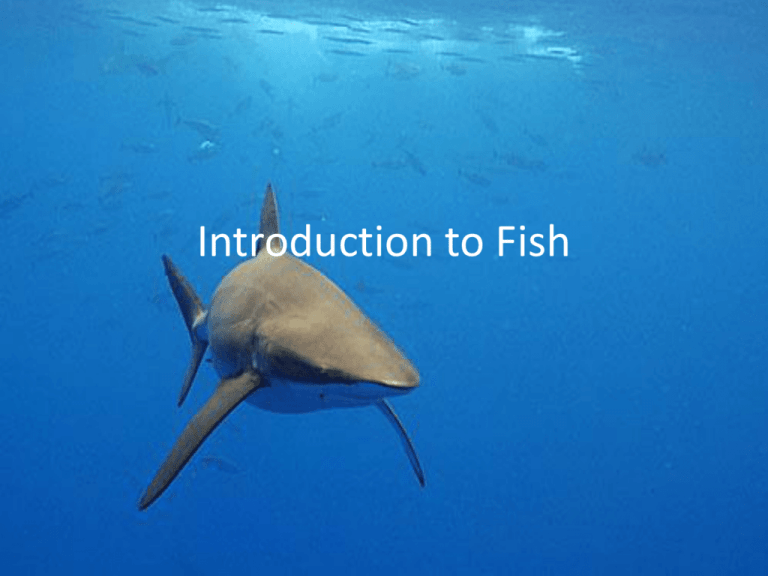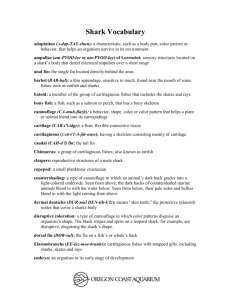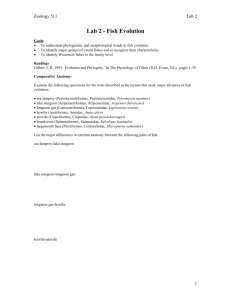Fish
advertisement

Introduction to Fish Phylum Chordata Subphylum Vertebrata Class Agnatha Class Chondrichthyes Class Osteichthyes Class Amphibia Class Reptilia Class Aves – Class Mammalia – – – – – – fish Class Agnatha - jawless fish: hagfish and lampreys • • • • absence of jaws no paired fins cartilaginous skeleton 2-chambered heart Basic Anatomy Class Agnatha • Possess medial nostril, medial fins, notocord rather than vertebral column • 7 or more pr gill pouches present • Light sensitive pineal eye • Fertilization external • Cartilaginous skeleton • Lack jaws, paired fins, scales • GI track w/out stomach • Lampreys and hagfish • 100 species Agnatha Class Agnatha Hagfish Jaw Development agnathostome 1st appeared 400 mya gnathostome Jaws evolved from gill supports. • Jaws developed from gill arches located around the pharynx. cranium cranium mouth • cranium gill arches mouth Jaws gave vertebrates a huge advantage as predators. mouth Only two groups of jawed fish still exist. • Cartilaginous fish and bony fish are still in existence. • Cartilaginous fish have skeletons made of cartilage. • Cartilaginous fish include the Holocephali and Elasmobranchs – Holocephali include ratfish, a small group of deep-sea fish. – Elasmobranchs include sharks, rays, and skates. Basic Anatomy Class Chondrichthyes Sharks, skates, rays • • • • • • • • • • Posses jaws with teeth, cartilaginous skeleton, paired fins Scales (denticles) have same origin and composition as teeth Possesses 5-7 gills Spiral valve intestine Ureoosmotic strategy Electroreception Lateral line No swim bladder Heterocercal tail Relatively unchanged (480 mybp) Cartilaginous fish Chondrichthyes Bronze whaler Eagle ray Chondrichthyes Basic Anatomy Class Osteichthyes • • • • • • • Posses jaws with teeth, bony skeleton, paired fins 4 paired gill arches covered by operculum Intestine- simple, no spiral valve Swim bladder Lateral line Homocercal tail Scales- cycloid, ctenoid Bony fish Swim bladder Fish are vertebrates with gills and paired fins. • Fish use specialized organs called gills to breathe underwater. – sheets of thick, frilly tissue filled with capillaries – take in dissolved oxygen from water, release carbon dioxide water flow • Countercurrent flow is the opposite movement of water against the flow of blood in the fish’s gills. Circulatory system of fish • Bony fish have skeletons made of bone. – operculum protects a bony fish’s gills – movements of operculum help bony fish move water over gills • Fins are surfaces that project from a fish’s body. – keep fish stable – redirect water around fish as it swims – help fish maneuver in water dorsal fin caudal fin pectoral fin anal fin pelvic fin Types of Fins The source of propulsion for virtually all fish 1. 2. 3. 4. comes from: Undulation of the body Paired Fins: • Pectoral • Pelvic Unpaired Fins: • Caudal • Dorsal • Anal A combination of the above Anguilliform swimming (Undulation) Dorsal & Anal Fin Propulsion Anal Fin Propulsion Black ghost knifefish Pectoral Fin Propulsion Dorsal fin Bowfin Sea horse Knifefish Pectoral Fin Frogfish Walking catfish Mudskipper •Myomeres – bands of muscle along sides of body contract pushing against water, forces body forward •Dorsal & anal fins – act as rudders to steer & provide stability (unpaired) •Pelvic fins – to turn, balance, & “brake” (paired) ● Pectoral fins – steering (paired) Fish senses • All fish have a lateral line system. – sensory system – sensitive to small changes in water movement lateral line Lateral line system Fish scales • Reduce drag and direct water flow Types of fish scales Fish Adaptations and Life Styles General Life Style Categories a. pelagic cruisers 1. occurring in water column far away from the bottom (benthic) environment 2. often referred to as "blue water" 3. includes tuna, billfish, blue sharks, mackerel sharks (great whites and mako sharks) b. demersal 1. bottom-associated fishes, but not usually sitting on the bottom 2. rely on the benthic environment as a source of food, place to reproduce, and/or place of refuge, etc. 3. includes most reef fishes (e.g., butterfly fishes, surgeon fishes, wrasses, parrot fishes, etc.) c. benthic 1. bottom-dwelling fishes that spend the majority of time sitting on the bottom 2. includes flatfishes, lizard fishes, many scorpion fishes, many hawkfishes, gobies, etc. Body shape tuna 1) fusiform a) = torpedo-shaped b) allows minimal drag while swimming c) best shape for a pelagic cruise 2) compressed a) laterally flattened (e.g., butterflyfishes & surgeonfishes) b) allows for maneuverability in surge environments c) useful for demersal fishes that hover above the reef d) exception seen in flatfishes that lie on one side of the body as benthic fishes John Dory: predator in waiting… 3) elongated or attenuated a) long body (e.g., trumpetfish, cornetfish, eels) b) seen in demersal fish that either hover motionless in the water) c) seen also in benthic fishes (e.g., eels) that hide in holes in the reef 4) depressed a) dorso-ventrally flattened (e.g., frogfishes, scorpionfishes & gobies) b) broad ventral surface facilitates resting on the bottom c) seen in many benthic fishes Body Coloration 1) source of color a) pigment color - chromatophores for yellows, reds, oranges, browns, & blacks b) structural color - iridophores (reflection) & light refraction for blues, silvers, & rainbows 2) patterns a) countershading 1) dark blue or black dorsally, white or silvery ventrally 2) results in blue water "camouflage“ 3) observed most frequently in pelagic cruisers b) camouflage 1) matching the background coloration 2) usually involves having irregular dark blotches and spots 3) typically seen in benthic fishes, especially benthic ambush predators (e.g., frogfishes, gobies, & many scorpionfishes) 4) some fishes (e.g., flatfishes) may exhibit rapid color changes in response to different backgrounds Cryptic colouration b) camouflage 5) matching downwelling light Hatchet fish Cookie cutter shark c) disruptive coloration 1) color pattern breaks up the silhouette of the fish 2) may involve dark bars across the eye and tail region 3) seen in many demersal fishes such as butterfly fishes d) bars and stripes 1) bars are vertical (e.g., manini) 2) stripes are horizontal (e.g., ta'ape) 3) seen frequently in schooling demersal fishes 4) may confuse potential predators by making it difficult to select individual prey from the school e) misdirection 1) false eye spots, etc. 2) observed in many demersal butterfly fishes f) advertising coloration 1) bright, obvious color patterns 2) possible functions a) advertising a cleaning station (e.g., cleaner wrasses) b) advertising a warning (e.g., nohu) c) advertising for mates (e.g., male parrotfishes) Hawaiian cleaner wrasse Nohu g) mimicry 1) imitating other creatures 2) seen in a few demersal and benthic fishes 3) examples a) blenny (Aspidontus taeniatus) mimics cleaner wrasses b) shortnose wrasse mimics Potter's angel which sports a defensive spine g) mimicry 4) leafy sea dragon (Australia) h) uniform red coloration 1) most often observed in deep-dwelling or night active demersal fishes 2) examples include opakapaka, oweoweo, menpachi, & squirrelfishes i) noctural versus diurnal color changes j) male versus female color differences k) juvenile versus adult color differences Dragon wrasse Stoplight parrotfish Bluehead wrasse Sex and social behaviour Territoriality Black angel fish Placoderm (395-345) Osteichthyes (395) Ostracoderm (510-=350 mybp) Chondrichthyes (370) lamprey & hagfish (360) Coelacanth Lungfish New Zealand Fish • Over 1,000 species, many in Indo-Pacific and Australia as well • Of the 270 coastal species, approx. 25% are endemic Triplefins Osteichthyes Parore: Herbiverous fish feeding on kelps and other algae • Demersal fish live on the sea floor • Pelagic fish live in the water column above Variations on a theme Osteichthyes Blue maomao : plankton feeders Trevalley : plankton feeders Snapper Leatherjacket Yellow-finned tuna Ostracoderm (510-=350 mybp) Placoderm (395-345) (360) lamprey & hagfish







